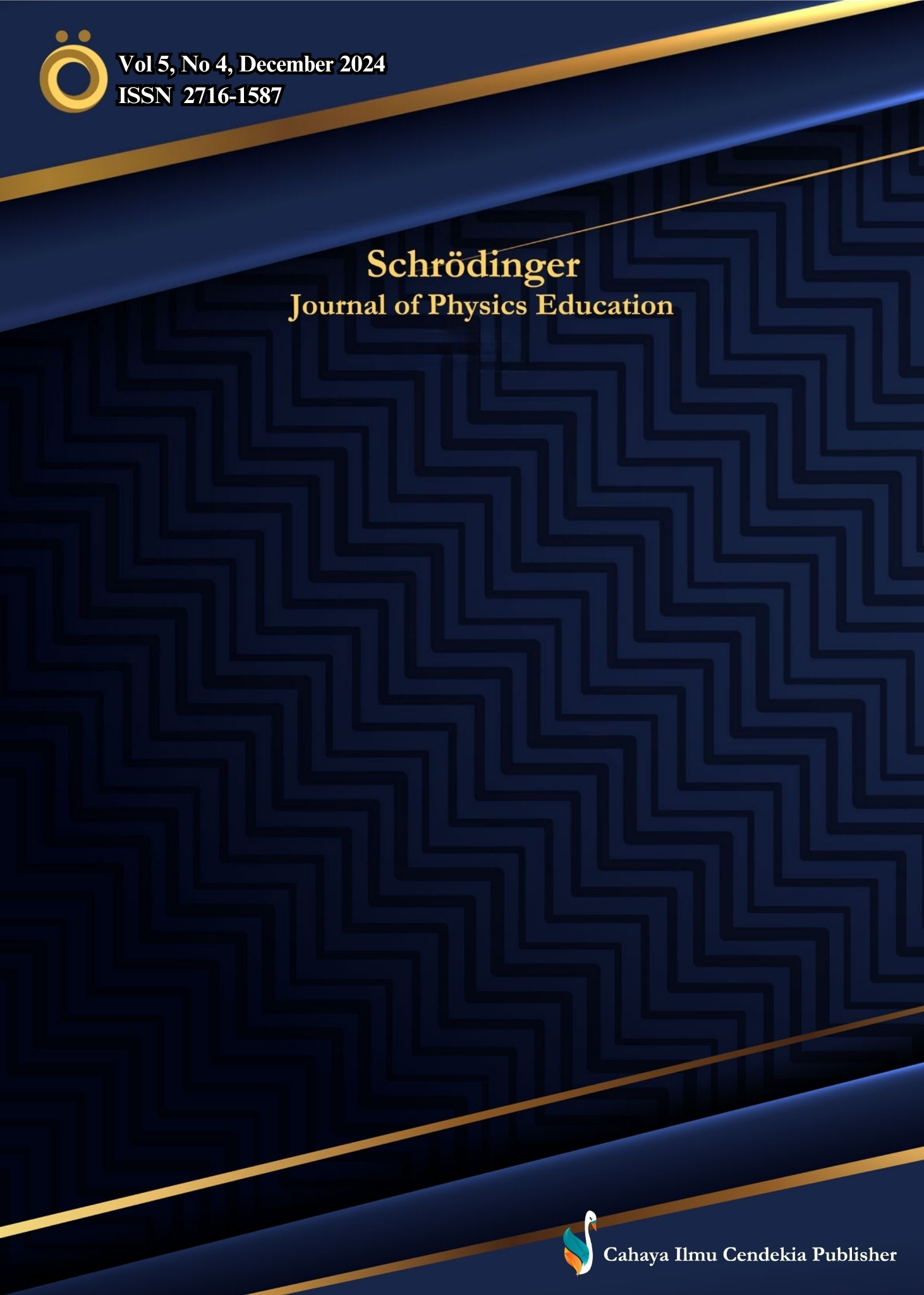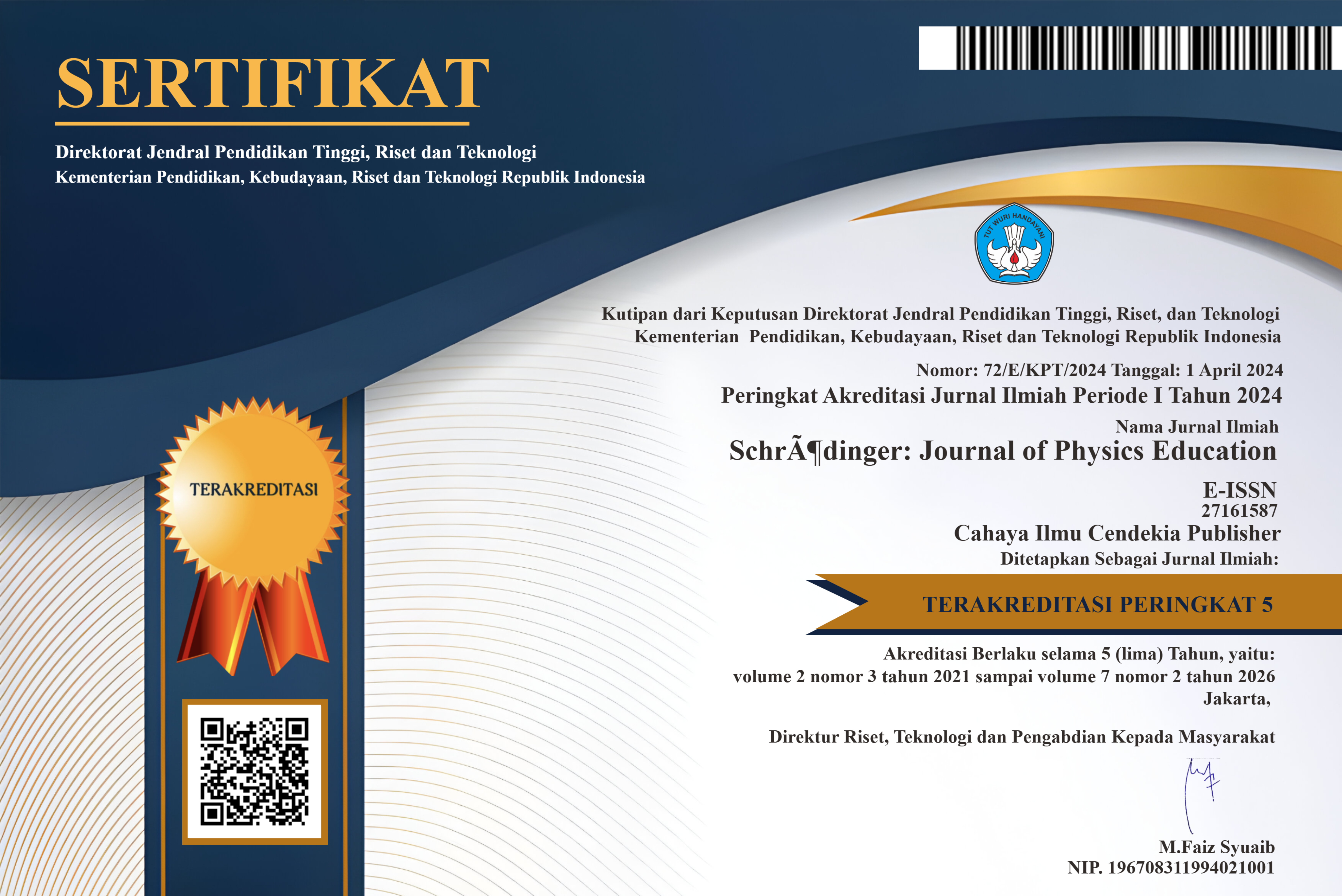Analyzing Ohm's Law: Comparison of Current and Resistance in Series and Parallel Circuits
Abstract
Purpose of the study: The purpose of this study is to analyze and compare the relationship between current and resistance in series and parallel circuits, and to verify the accuracy of Ohm's Law through experimental measurements and theoretical calculations.
Methodology: This study uses a Pre-Experimental Design (One-Group Post-Test Only Design), involving 10 series and 10 parallel circuits with resistors of varying values. Measurements of current and resistance were taken using a digital multimeter and ohmmeter. Data collection occurred at three time points (start, 5 minutes, 10 minutes). The data was compared with theoretical values based on Ohm's Law.
Main Findings: The experiment showed that in a series circuit, the current increased proportionally with the applied voltage, consistent with Ohm's Law. In parallel circuits, the current also increased with voltage, but at a higher rate compared to series circuits. The resistance measured in both circuit types was consistent with theoretical calculations, with minor percentage errors observed in both configurations.
Novelty/Originality of this study: This study offers a fresh perspective by analyzing the application of Ohm’s Law in both series and parallel circuits, comparing real experimental data with theoretical calculations. It advances existing knowledge by providing a practical verification of theoretical concepts, enhancing understanding of current distribution and resistance effects in different circuit configurations, which can benefit students and professionals in electronics.
References
A. Monti and F. Ponci, Electric power systems, vol. 565. 2015. doi: 10.1007/978-3-662-44160-2_2.
P. W. T. Pong et al., “Cyber-enabled grids: Shaping future energy systems,” Adv. Appl. Energy, vol. 1, no. October 2020, p. 100003, 2021, doi: 10.1016/j.adapen.2020.100003.
J. P. Burde and T. Wilhelm, “Teaching electric circuits with a focus on potential differences,” Phys. Rev. Phys. Educ. Res., vol. 16, no. 2, p. 20153, 2020, doi: 10.1103/PhysRevPhysEducRes.16.020153.
N. O. Laschuk, E. B. Easton, and O. V. Zenkina, “Reducing the resistance for the use of electrochemical impedance spectroscopy analysis in materials chemistry,” RSC Adv., vol. 11, no. 45, pp. 27925–27936, 2021, doi: 10.1039/d1ra03785d.
H. C. Lewis et al., “Magnetospheric Multiscale measurements of turbulent electric fields in earth’s magnetosheath: How do plasma conditions influence the balance of terms in generalized Ohm’s law?,” Phys. Plasmas, vol. 30, no. 8, 2023, doi: 10.1063/5.0158067.
M. Erol and E. B. Önder, “Conceptual framework on teaching capacitors and inductors,” Momentum Phys. Educ. J., vol. 5, no. 2, pp. 182–193, 2021, doi: 10.21067/mpej.v5i2.5630.
N. Xi, J. Chen, F. Gama, M. Riar, and J. Hamari, “The challenges of entering the metaverse: An experiment on the effect of extended reality on workload,” Inf. Syst. Front., vol. 25, no. 2, pp. 659–680, 2023, doi: 10.1007/s10796-022-10244-x.
T. Hennig-Thurau, D. N. Aliman, A. M. Herting, G. P. Cziehso, M. Linder, and R. V. Kübler, “Social interactions in the metaverse: Framework, initial evidence, and research roadmap,” J. Acad. Mark. Sci., vol. 51, no. 4, pp. 889–913, 2023, doi: 10.1007/s11747-022-00908-0.
E. F. M. Jr, “Enhancing Student Learning Motivation in Physics Through Interactive Physics Education Technology ( PhET ) Simulation,” SchrödingerJournal Phys. Educ., vol. 5, no. 3, 2024, doi: 10.37251/sjpe.v5i3.1025.
K. Manunure, A. Delserieys, and J. Castéra, “The effects of combining simulations and laboratory experiments on Zimbabwean students’ conceptual understanding of electric circuits,” Res. Sci. Technol. Educ., vol. 38, no. 3, pp. 289–307, 2020, doi: 10.1080/02635143.2019.1629407.
P. Heering, J. Keck, and G. A. Rohlfs, “Laboratory Notes, Laboratory Experiences, and Conceptual Analysis: Understanding the Making of Ohm’s First Law in Electricity,” Ber. Wiss., vol. 43, no. 1, pp. 7–27, 2020, doi: 10.1002/bewi.201900019.
S. D. Kang and J. H. Kim, “Investigation on the insulation resistance characteristics of low voltage cable,” Energies, vol. 13, no. 14, 2020, doi: 10.3390/en13143611.
A. M. Kimuya, “Modeling Signal Integrity in High-Frequency and Radio Frequency Circuits : A Comparison of Ohm ’ s Law Variants Modeling Signal Integrity in High-Frequency and Radio Frequency Circuits : A Comparison of Ohm ’ s Law Variants,” Emerg. Technol. Eng. J., vol. 1, no. 2, pp. 1–29, 2024, doi: 10.53898/etej2024121.
A. M. KIMUYA, “the Modified Ohm’S Law and Its Implications for Electrical Circuit Analysis,” Eurasian J. Sci. Eng. Technol., vol. 4, no. 2, pp. 59–70, 2023, doi: 10.55696/ejset.1373552.
R. Eisenberg, “Circuits , Currents , Kirchhoff , and Maxwell,” Qeios, vol. 3, no. May, 2023, doi: 10.32388/L9QQSH.3.
M. Khalid Ratib, K. M. Muttaqi, M. R. Islam, D. Sutanto, and A. P. Agalgaonkar, “Electrical circuit modeling of proton exchange membrane electrolyzer: The state-of-the-art, current challenges, and recommendations,” Int. J. Hydrogen Energy, vol. 49, pp. 625–645, 2024, doi: 10.1016/j.ijhydene.2023.08.319.
P. Irving, R. Cecil, and M. Z. Yates, “MYSTAT: A compact potentiostat/galvanostat for general electrochemistry measurements,” HardwareX, vol. 9, p. e00163, 2021, doi: 10.1016/j.ohx.2020.e00163.
S. Xie et al., “Development of Broadband Resistive–Capacitive Parallel–Connection Voltage Divider for Transient Voltage Monitoring,” Energies, vol. 15, no. 2, 2022, doi: 10.3390/en15020451.
J. Xu, M. Feng, and C. Zhao, “Modular Reciprocating HVDC Circuit Breaker with Current-limiting and Bi-directional Series-parallel Branch Switching Capability,” J. Mod. Power Syst. Clean Energy, vol. 8, no. 4, pp. 778–786, 2020, doi: 10.35833/MPCE.2019.000292.
G. W. Jaya and S. V. Aponno, “Kajian teori arus listrik dan daya listrik pada rangkaian resistor seri dan paralel berdasarkan jumlah resistor yang digunakan,” ORBITA. J. Has. Kajian, Inovasi, dan Apl. Pendidik. Fis., vol. 9, no. 1, pp. 87–93, 2023.
M. L. Tomkelski, M. Baptista, and A. Richit, “Physics teachers’ learning on the use of multiple representations in lesson study about Ohm’s law,” Eur. J. Sci. Math. Educ., vol. 11, no. 3, pp. 427–444, 2023, doi: 10.30935/scimath/12906.
T. J. Hartanto, P. A. C. Dinata, N. Azizah, A. Qadariah, and A. Pratama, “Students’ Science Process Skills and Understanding on Ohm’s Law and Direct Current Circuit Through Virtual Laboratory Based Predict-Observe-Explain Model,” J. Pendidik. Sains Indones., vol. 11, no. 1, pp. 113–128, 2023, doi: 10.24815/jpsi.v11i1.27477.
I. Rahman and M. Johari, “Students’ understanding and skills on voltage and current measurements using hands-on laboratory and simulation software,” Educ. Inf. Technol., vol. 27, no. 5, pp. 6393–6406, 2022, doi: 10.1007/s10639-022-10890-3.
C. Stolzenberger, F. Frank, and T. Trefzger, “Experiments for students with built-in theory: ’PUMA: Spannungslabor’-an augmented reality app for studying electricity,” Phys. Educ., vol. 57, no. 4, 2022, doi: 10.1088/1361-6552/ac60ae.
Z. Li, W. Jiang, A. Abu-Siada, Z. Li, Y. Xu, and S. Liu, “Research on a Composite Voltage and Current Measurement Device for HVDC Networks,” IEEE Trans. Ind. Electron., vol. 68, no. 9, pp. 8930–8941, 2021, doi: 10.1109/TIE.2020.3013772.
D. Tzelepis et al., “Voltage and current measuring technologies for high voltage direct current supergrids: A technology review identifying the options for protection, fault location and automation applications,” IEEE Access, vol. 8, pp. 203398–203428, 2020, doi: 10.1109/ACCESS.2020.3035905.
M. Savytskyi, K. Sukhyy, O. Savytskyi, M. Babenko, and T. Shevchenko, “Carbon materials for electrically conductive concrete,” E3S Web Conf., vol. 534, 2024, doi: 10.1051/e3sconf/202453401019.
M. Chekour, Y. Z. Seghroucheni, M. A. Tadlaoui, and M. M. Hafid, “Blended Learning and Simulation for Teaching Electrical Concepts to High School Pupils,” J. Turkish Sci. Educ., vol. 19, no. 4, pp. 1119–1134, 2022, doi: 10.36681/tused.2022.165.
A. B. Hidayah, M. I. Sadri, Safruddim, M.Rafli, and A. I. D. Puspita, “Design and Implementation of a Composite Array Resistivity Data Logger for High-Resolution 2D Inversion Modeling,” J. Geosci. Eng. Environ. Technol., vol. 8, no. 1, pp. 44–55, 2023, doi: 10.25299/jgeet.2023.8.1.10875.
R. N. H. Arif, “Kajian literatur: identifikasi soal pemahaman konsep fisika pada materi ajar listrik dinamis,” BIOCHEPHY J. Sci. Educ., vol. 4, no. 2, pp. 880–889, 2024, doi: 10.52562/biochephy.v4i2.1399.
Jusnydar.J and Anggi Almirah Khusnah, “Analisis Rangkaian Listrik DC Menggunakan Software Proteus 8 Proffesional,” Mokula J. Ilmu Pendidik. Dan Sains Fis., vol. 1, no. 1, pp. 1–6, 2024, [Online]. Available: https://mail.usn.ac.id/753journal/index.php/MOKULA/article/view/147
Copyright (c) 2024 Kuni Afrida Imtiyaaza, Safira Aila As’ari, Khoirunnisa Aprilia Cahyani, Faradilla Sari Nurbayana, Zurrotur Rofiqotin Zahro, Friscela Yona Nagifea, Sudarti Sudarti, Habibah Khusna Baihaqi

This work is licensed under a Creative Commons Attribution 4.0 International License.
Authors who publish with this journal agree to the following terms:
- Authors retain copyright and acknowledge that the Schrödinger: Journal of Physics Education is the first publisher licensed under a Creative Commons Attribution 4.0 International License.
- Authors are able to enter into separate, additional contractual arrangements for the non-exclusive distribution of the journal's published version of the work (e.g., post it to an institutional repository or publish it in a book), with an acknowledgment of its initial publication in this journal.
- Authors are permitted and encouraged to post their work online (e.g., in institutional repositories or on their website) prior to and during the submission process, as it can lead to productive exchanges and earlier and greater citation of published work.







.png)
.png)








.png)
.png)
.png)







